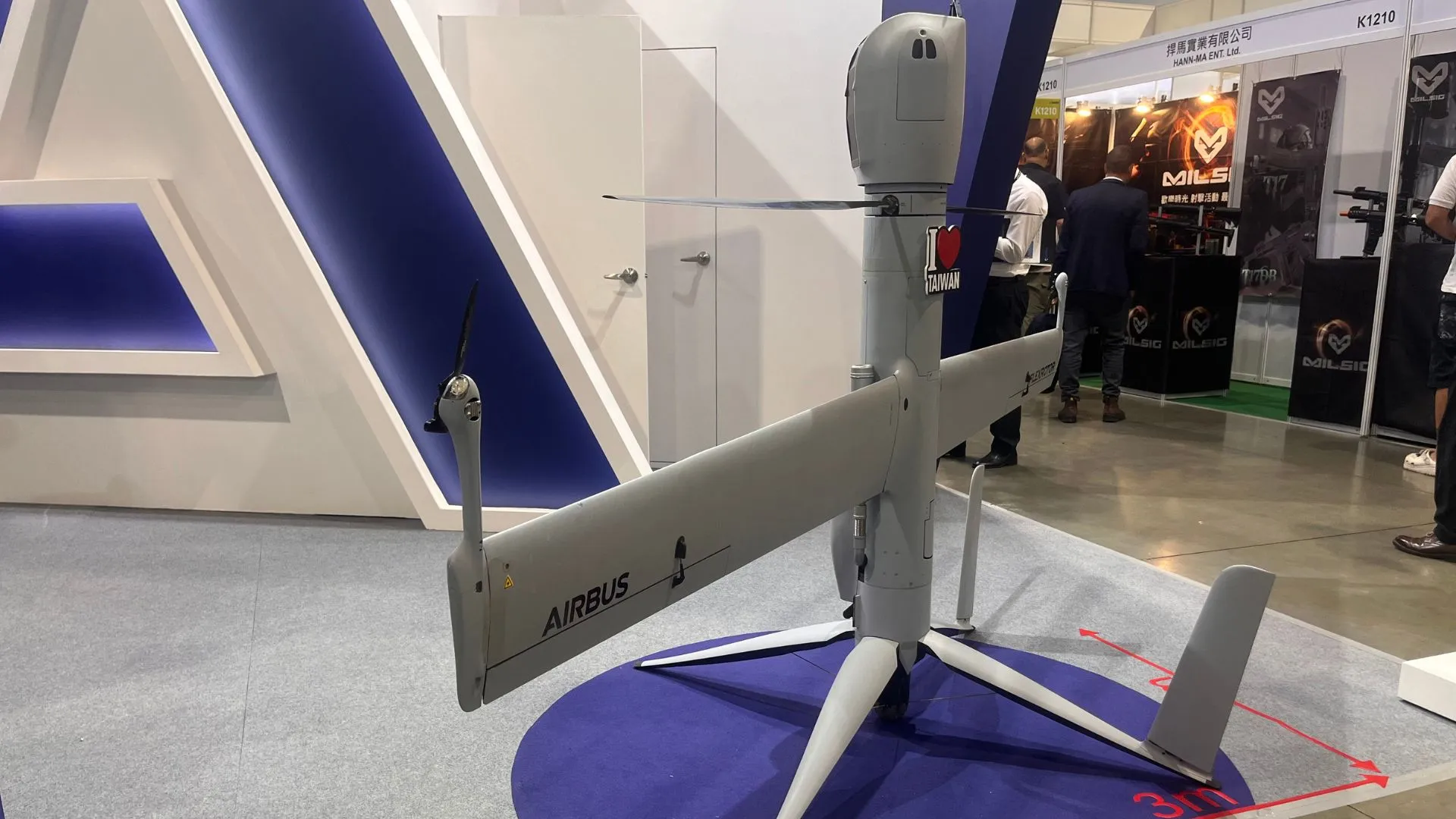
Military
Treating drones like bullets: Inside Taiwan’s 50,000 UAV plan to deter China
At the Taipei Aerospace & Defense Technology Exhibition 2025, Taiwan’s state developers and private firms showcased a full-spectrum unmanned ecosystem.
Updated: Oct 01, 2025 09:41 AM EST
1
🚀
Trump rolls out ‘TrumpRx’, Pfizer deal to drive down US drug costs by up to 80%
Aamir Khollam
16 hours ago
2
🚀
Watch: Skateboarder turns 22-story skyscraper into giant ramp, sets world records
Sujita Sinha
a day ago
3
🚀
US Army tests kamikaze drone that flies like a drone and strikes like a missile
Kapil Kajal
a day ago
4
🚀
Spider-like welding robot and humanoid robot debut in shipyards, city streets
Atharva Gosavi
a day ago
5
🚀
China claims its new naval laser outperforms powerful US Helios for drone defense
Abhishek Bhardwaj
a day ago
6
🚀
8-milligram marvel: Ant-inspired robot responds to heat, humidity and magnetism
Mrigakshi Dixit
a day ago
7
🚀
China deploys planetary defense prototype that can track 1,000 incoming missiles
Sujita Sinha
a day ago
8
🚀
GPT-5 model helps crack one of quantum computing’s most stubborn open problems
Aamir Khollam
2 days ago
9
🚀
Ultrafast flash heating recovers rare earths from electronic waste with 90% yield
Neetika Walter
2 days ago
10
🚀
Humanoid robots get smarter muscles and sharper minds with NVIDIA’s latest arsenal
Neetika Walter
2 days ago
1
🌟
Scientists record ‘first heartbeat’ of one of the most extreme objects in universe
Chris Young
5 minutes ago
2
🌟
US breakthrough settles decades-old debate on graphite’s role in nuclear reactors
Aman Tripathi
12 minutes ago
3
🌟
Chinese ‘golf carts’ repurposed as remote-controlled battlefield robots by Russia
Atharva Gosavi
15 minutes ago
4
🌟
Jet-powered humanoid robot baby achieves robust flight control in simulations
Kaif Shaikh
17 minutes ago
5
🌟
Egypt: 3,300-year-old bone whistle may have helped guards deter ‘grave robbers’
Mrigakshi Dixit
27 minutes ago
6
🌟
Treating drones like bullets: Inside Taiwan’s 50,000 UAV plan to deter China
Kapil Kajal
28 minutes ago
7
🌟
US fusion engineering platform hits internal record, boosting power 20 times
Aman Tripathi
34 minutes ago
8
🌟
China’s mystery hypersonic missile test leaves unusual doodle-like plume in sky
Kapil Kajal
2 hours ago
9
🌟
Carbon cycle ‘flaw’ can overshoot, plunging Earth into potential Ice Age: Study
Mrigakshi Dixit
2 hours ago
10
🌟
China debuts ‘world’s mightiest’ centrifuge hitting 300 times Earth’s gravity
Sujita Sinha
3 hours ago
Kapil Kajal
An Airbus drone showcased at TADTE 2025.
IE/Kapil Kajal
In September 2025, Taiwan opened its doors to the world to see its growth in defense capabilities. The island hosted its largest defense exhibition, showing a clear change in its strategy and manufacturing approach to confront China.
The island’s focus is now on using unmanned systems that are easy to deploy at low cost. The strategy aims to speed up production and apply lessons from the Ukraine conflict to develop unique defenses for the Taiwan Strait.
The centerpiece is a two-year plan to procure roughly 50,000 domestically built drones across five categories by 2027, paired with a policy shift to treat small UAVs as “consumables.”
This approach reframes procurement in terms of throughput and replaceability rather than platform longevity, and it aligns budgets, training, and sustainment with the reality of high-loss, high-tempo drone warfare.
At the Taipei Aerospace & Defense Technology Exhibition (TADTE) 2025, Taiwan’s state developers and private firms showcased a full-spectrum unmanned ecosystem, low-cost autonomous cruise drones, loitering munitions, swarming first-person view (FPVs), maritime unmanned surface vehicles (USVs), AI-enabled command-and-control, and secure non-China supply chains, indicating a production footing rather than a prototype showcase.
Treating drones like bullets
The concept of treating drones like ammunition is not rhetorical; it is a structural decision to flip cost and complexity onto the attacker by massing distributed, expendable sensors and effectors.
In practical terms, it demands standardized interfaces across classes; modular payloads for intelligence, surveillance, and reconnaissance (ISR), strike, and decoy roles; and an industrial model that privileges short assembly cycles, vendor redundancy, and rapid iteration.
Taiwan’s tender architecture is divided into two parts for 2026 and 2027. It requires quarterly deliveries and sets clear acceptance criteria. It also excludes any components made in China for important electronics, radios, optics, and firmware.
The doctrinal end state for 2027 is not a single “drone capability” but a layered, networked kill web: persistent ISR and targeting at scale; attritable precision effects at the tactical edge; and saturation constructs that impose drive-down economics on a numerically superior adversary.
Interviews conducted at the show provide on-record clarity on design intent, assembly doctrine, and operational roles.
Major Jacky Chao from Taiwan’s Ministry of National Defense (MND) described a teaming model between Taiwan’s drone vendors and the 22nd Arsenal’s munitions expertise aimed at delivering “effective cost” air systems with rapid assembly and short production cycles.
He told Interesting Engineering that the operational logic is in stark, utilitarian terms: substitute unmanned attrition for human risk, such that one drone can kill a tank or a ship without friendly personnel exposed.
That objective, “destroy a tank or a ship” at low cost, anchors a family-of-systems approach where airframes, seekers, warheads, and control stacks are engineered to be consumable, manufacturable, and upgradeable on short cycles.
Lieutenant (j.g.) Wu, Taiwan’s MND, told Interesting Engineering that a naval-aligned “land mass reconnaissance” UAV used to deny amphibious landings through reconnaissance, identification, and battle damage assessment.
He noted that 12 systems are already in Navy service, with EO/IR and laser payloads providing coordinates and real-time imagery to ground control stations, a confirmation that this is not a paper concept but a fielded capability informed by Ukraine’s compression of find–fix–finish timelines.
State-developed low-cost drones
Taiwan’s state-run National Chung-Shan Institute of Science and Technology’s (NCSIST) technical posture centers on two axes: extending range and survivability for standoff effects, and driving down unit cost for tactical mass.
The low-cost autonomous cruise missile (LCACM) co-developed with US firm Anduril is designed for ground launch and optimized for independent or swarm employment, intentionally positioned beyond the typical loitering-munition envelope to straddle anti-landing and anti-ship roles.
The airframe highlights low-altitude profiles, modularity for future seeker integration, and autonomy modes that reduce C2 exposure under jamming.
Program officials set a two-year path to mass production following test completion, with full Taiwan manufacture and target unit costs in the low hundreds of thousands USD, deliberately priced for salvo fire.
In parallel, the Mighty Hornet family moves on two tracks. Mighty Hornet IV leverages a proven target-drone fuselage lineage to produce a multi-role decoy/strike/ISR/target platform with roughly 1,000 km class range; the transition plan replaces stock engines with Taiwanese “consumable” engines to hold unit cost below approximately US$300,000 after flight testing and to localize sustainment.
Mighty Hornet III is a fully indigenous anti-armor loitering munition with an X‑wing planform enabling rapid lateral slews and vertical launch from a flat surface, eliminating tube launchers, reducing setup signatures, and expanding deployment flexibility.
The cited unit price near NT$1.5 million is tuned for battalion-level massing in attritional warfare, with operational testing and evaluation scheduled to conclude this year.
Taiwan’s maritime layer is being built with equal attention to cost, speed, and saturation. The Kuai Chi attack USV, conceived explicitly for Taiwan’s coastal terrain, combines 40‑knot sprints from a three-ton single hull, several hundred miles’ range, and a mixed payload of tube-launched loitering munitions plus a kinetic terminal option.
The design objective is “decisive coastal battles” fought through numbers: many small, fast, stealthy, maneuverable USVs that overwhelm escorts and disrupt amphibious staging in littoral choke points.
More importantly, USV–UAV convergence is operationalized: a USV can launch loitering munitions, relay data for overhead UAVs, and absorb fires while the air layer completes the kill chain.
When paired with shore-launched loitering salvos and dispersed ISR nodes, these concepts form a littoral saturation complex that stresses adversary air defenses, decoys their sensors, and complicates engagement prioritization.
Private players not behind
Private industry has moved beyond showcasing singular platforms to presenting suites that cover air, sea, and land, emphasizing secure supply chains and certified control stacks.
Thunder Tiger Group, a listed company with 45 years’ heritage in RC aircraft, exemplifies this breadth. The firm’s SeaShark 600 stealth USV is designed for near-shore ISR, attack, and swarm roles.
The T‑400 attack drone integrates laser-guided rockets with real-time video links for precision strike and extended loiter. At the same time, suicide-attack FPVs incorporate AI navigation for autonomous terminal guidance under degraded control.
The company also displayed a UGV with automated firepower and integrated drone launch, offering mobile ground fire support in contested urban or coastal zones.
Thunder Tiger’s General Manager Jinhu told Interesting Engineering that the company’s drones have “100% non‑Chinese” components, flight-control cybersecurity certification, and participation in five government tenders valued at around US$2 billion, with endurance and performance trials underway with the armed forces.
The firm’s export posture and openness to partnerships in India and across Asia signal a dual-use industrial strategy: meet domestic mass first, then leverage scaled lines and sovereign supply chains for regional security cooperation.
The enabling layer is more than a footnote; it is the difference between a fleet of airframes and a fielded capability. Several vendors presented hardened edge C2 ecosystems designed to survive contested EMS with LPI/LPD links, mesh networking, burst communications, and sovereign encryption, all packaged for quick deployment and decentralized control.
A wirelessly powered dual‑drone demonstration pointed to persistent ISR in base-defense perimeters without frequent battery cycles, useful for fixed-site surveillance and early warning. Across the show floor, 3D‑printed airframes and components highlighted a design-to-fab culture that prioritizes speed. This is not cosmetic.
By printing jigs, control surfaces, and structural shells, firms cut weeks to days in iteration cycles, incorporate field feedback rapidly, and lower unit costs, which is key when loss rates for FPV and small ISR drones are measured per day in high-intensity conditions.
50,000 drones by 2027?
Industrial capacity, and the constraints that shape it, remain the crux of the 2027 question. A two-year plan to deliver nearly 50,000 drones across five categories requires synchronized advances in contracting, supplier certification, training, and sustainment.
Contracting parameters must translate target numbers into quarterly delivery schedules with penalties and incentives; the initial pool of qualified primes must be augmented by tiered suppliers for motors, power systems, optics, and radios that pass tamper-resistant and non-China component audits.
The battery and motor bottleneck is a hard constraint for FPVs and larger multirotors: Taiwan’s electronics base can expand pack production and BMS integration. However, raw cell sourcing is global and should be covered with buffer inventories and prepositioned chargers near likely axes.
For longer-range fixed-wing and cruise classes, the shift to domestic “consumable” combustion engines, already planned in the Mighty Hornet IV transition, reduces foreign dependencies and holds unit costs within salvo affordability.
Training and EW-hardening are the next decisive variables. Reclassifying drones as consumables does not reduce the need for skilled operators, maintainers, and EW specialists, particularly for hybrid VTOL fixed-wings and cruise drones.
Ukraine’s model of unit-level drone academies, standardized syllabi for FPV, ISR, and loitering units, and a pipeline of instructor cadres can be adapted to Taiwan’s reserve structure and mobilization pathways.
On the technical side, navigation fallbacks must be engineered as defaults rather than contingency add-ons: fused INS/visual odometry, terrain-relative navigation, multi‑constellation GNSS with controlled radiation pattern antennas, and autonomy that allows missions to continue under comms loss.
Datalinks should be treated as ephemeral: frequency hopping, power control, short duty cycles, and pre-planned mission autonomy reduce dependencies on persistent control. Kill-chain acceleration through AI-assisted target recognition and automated BDA loop closure reduces exposure windows and increases the probability that each sortie yields actionable effects.
Europe and Ukraine’s entry into Taiwan
International vectors beyond the United States are becoming integral to scale, software, and training.
Taiwan’s MOUs with Poland and Ukraine are not symbolic. Poland’s emergence as a leading European importer of Taiwanese drones provides a market-validated export channel and an EU-standard QA benchmark.
Ukrainian inputs accelerate software maturation where it matters: EW-aware FPV autopilots, mission planners tuned for swarming salvos, datalink discipline, and rapid field repair SOPs that cut turnaround times in austere conditions. Together, these partnerships diversify supply risk, deepen software resilience, and create potential co-repair and training hubs that can be activated in contingencies.
With US collaborations running in parallel, autonomous cruise with Anduril, Mighty Hornet IV lineage with Kratos, VTOL fixed-wing sustainment and autonomy collaboration with AeroVironment, the ecosystem reflects a deliberate choice to avoid single-nation dependencies while absorbing the fastest-moving combat lessons on the planet.
Sustainment beyond 2027 will be defined by logistics and doctrine rather than any single platform. Budgets must anticipate the shift in recurring costs from airframes to batteries, optics, flight controllers, and ground control stations, items consumed in large numbers or cycled hard in training.
A sustainable model standardizes payload and power/data buses across drone classes, centralizes bulk procurement of high-cost gimbals and designators, prepositions spares and chargers near likely axes, and enforces rolling QA and cybersecurity audits across private suppliers.
The doctrine must commit to iterative refresh cycles every 6–12 months, keyed to adversary countermeasures. This mindset is as much as a plan: expect losses, adapt faster, and measure success by the cost imposed on the adversary’s sensors, interceptors, and time.
Is Taiwan ready to take on the mighty dragon?
Measured against these requirements, Taiwan’s 2025 baseline is credible and mobilizing. TADTE 2025 showcased platforms and an industrial posture, 3D‑printed structures, consumable engines, edge C2 stacks, sovereign supply chains, and unit-level training pathways, aligned to a two-year surge.
On-record interviews indicate that naval UAVs for anti-landing denial are already in service; loitering munitions are approaching operational test completion with price points set for mass; autonomous cruise drones are on a near-term test-to-production path with local manufacture.
Private firms are filling in the attritable strata with FPVs and multirotors designed for swarming and precision drops, and they are doing so within a non‑Chinese component framework and a cybersecurity certification regime that meets defense ministry mandates.
Meanwhile, the European and Ukrainian vectors provide software, training, and export scaffolding that reduce risk and shorten learning curves.
Whether Taiwan will have “tempo rather than inventory snapshots best answer enough drones by 2027” to face China.
The relevant metrics are quarterly deliveries versus tender targets; the number of operators and maintainers certified; serviceability and attrition rates in field exercises; EW-jamming and spoofing trial results; integration milestones for MUM‑T and USV–UAV coastal denial; and the conversion of MOUs in Europe into funded workshares, export approvals, and co-repair hubs. If those indicators trend as planned, Taiwan’s drone force will do more than emulate Ukraine.
It will be Strait-specific: a coastal-denial lattice that fuses shore, sea, and air; an ISR–strike fabric that closes loops quickly under EW pressure; and an attritable mass that raises the price of amphibious ambition beyond prudence.
The strategic effect of this shift is not only material but temporal. Taiwan converts time into a weapon by turning drones into throughput problems, from design to fab to field to refresh. That is the essence of asymmetric warfare in the 2020s: impose smaller, faster cycles on a larger adversary whose advantages favor long programs and complex systems.
If the island sustains the tempo set at TADTE 2025, procurement, training, software hardening, and industrial scaling, its unmanned ecosystem will be more than a check on aggression; it will be a continuously adapting field of friction, where numbers, autonomy, and secure networks make each day harder for any attacker than the one before.
ABOUT THE AUTHOR
Kapil Kajal Kapil Kajal is an award-winning journalist with a diverse portfolio spanning defense, politics, technology, crime, environment, human rights, and foreign policy. His work has been featured in publications such as Janes, National Geographic, Al Jazeera, Rest of World, Mongabay, and Nikkei. Kapil holds a dual bachelor’s degree in Electrical, Electronics, and Communication Engineering and a master’s diploma in journalism from the Institute of Journalism and New Media in Bangalore.
RELATED ARTICLES
JOBS
Loading opportunities…



